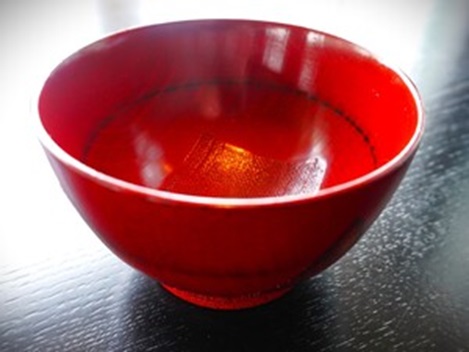2024.04.18
伝検通信(メルマガ)週刊メールマガジン「伝検通信」 第4号
週刊メールマガジン「伝検通信」第4号をお届けします。
今号も、日本伝統文化検定協会理事による連載「宙ちゃんの『伝統文化一直線』」をお送りします。
「クイズで肩慣らし」は前回クイズの解答・解説と、伝統色・文様分野からの出題です。
7月末までにメルマガ登録した方の中から、抽選で100人に公式テキストをプレゼントするキャンペーンも引き続き実施中です。それでは第4号スタートです。
目次
・宙ちゃんの「伝統文化一直線」第3回 経年劣化と経年美化
・「クイズで肩慣らし」第4回(伝統色・文様)=「吉祥文様」
・伝検協会だより
宙ちゃんの「伝統文化一直線」 第3回 経年劣化と経年美化
近藤宙時=日本伝統文化検定協会理事

写真/和歌山県の伝統工芸である「根来塗」
前回のコラムで、「匠(たくみ)の技」が生み出す伝統工芸品の価値が核家族化によって奪われてしまったと書きました。日本の木造住宅や、たんすなどの家具、伝統工芸の集積である仏壇は、子々孫々まで代々にわたって使われることを前提にしています。工業製品は時間が経過するにつれて劣化していきますが、伝統工芸品は「経年美化」こそが最大の特徴です。ところが、家族がバラバラになる時代にあっては誰もそうした価値を顧みなくなり、何百年も持つことが過剰品質になってしまったのです。
大量生産・大量消費の時代に生まれ、「消費は美徳」と言われながら育った昭和人間としては、「経年」に続く単語は「劣化」の一言であり、他の単語が来るとは思いも寄りませんでした。ですから経年美化という言葉を初めて聞いた時は、一瞬の「?」の後で小さなショックを受けざるを得なかったほどです。
30年も前になるでしょうか。当時の伝統工芸士会の会長さんにお会いした時でした。「量産品と、会長が作られるような工芸品との違いは何ですか」と問うと、会長さんは間髪入れず「それは経年劣化と経年美化の違いです」とおっしゃったのです。私の当惑ぶりを見て取った会長さんは、こう説明してくれました。「物ができた時、つまり出荷時点が最高なのが量産品。それに対し、使うほどに手になじみ、味が出て、数十年、百年という時を経て輝くのが工芸品です」
実にうなずける話でした。家電を筆頭に、工業製品は使うほどに悪くなります。経年劣化の典型でしょう。また、日進月歩で高性能な製品が世に出される工業社会に生きてきた身にとっては、たとえ使われていなくても、最新型こそが最高性能であり、古い物は劣悪な物でしかありませんでした。しかし、真逆の価値を持つものが同じ日本にあり、脈々と受け継がれてきていたのです。
例えば、根来塗(ねごろぬり)という漆器があります。もともとは和歌山県の北部にある新義真言宗の総本山、根来寺の僧が日頃の修行の中で使うための食器として作られました。頑丈にするため、黒漆で下地を塗り上げた後に、辰砂(しんしゃ=硫化水銀を含む鉱石で、古くから赤色の塗料として珍重された)を使った朱色の漆塗を施しています。
これを何十年、百年と大切に使っていると、指の摩擦で自然と朱色が薄くなり、下地の黒が顔を出して、朱の地に黒が斑紋のように浮かび上がってきます。さらに使い込むと、やがて朱色の部分が少なくなり、今度は黒地に朱の斑紋という反対の景色が現れます。もちろん、作られた当初の朱一色の時も美しいのですが、使われるほどにさらに美しくなる。それは、歳月という自然が作り出した、掛け替えのない美にほかなりません。ここにも、自然を友として、これを楽しむという日本の伝統文化の神髄が表れています。
経年美化を目にするには、職人が丹精込めて作るだけでは足りません。使う側もそれを慈しみ、大切に扱ってこその経年美化であり、職人が生んだものを使う人が育てるという共同作業がなければ得られないものです。経年美化という言葉は、使い捨て文化を見直すサステナブルな社会を象徴しているような気がします。
次回は5月第2週。テーマは「和食がユネスコ無形文化遺産となった決め手」です
「クイズで肩慣らし」第4回(伝統色・文様)
~伝検公式テキスト(9月刊行予定)のジャンルごとに出題します~

日本映画史上最大のヒットを記録したアニメのヒロインの着物に描かれていた柄で、日本の伝統的な吉祥文様の一つ。世界的に知られたこの文様の名前は何でしょうか?
【前回の解答と解説】
問題:香川県の伝統的工芸品「香川漆器」で、何度も漆を塗り重ねた上に文様を線彫りし、そのくぼみに色漆を埋め込む独特な技法は何と呼ばれるでしょうか?
答え:蒟醤(きんま)
解説:漆芸の加飾技法の一つ。漆地に特殊な蒟醤(きんま)刀で文様を線彫りし、彫溝に色漆を埋めて平らに研ぎ出し、文様を描き出す技法。緻密な線と色彩の美しさが特徴だ。江戸時代後期の漆工職人である玉楮象谷(たまかじ・ぞうこく)がタイや中国から伝わった漆器技法を研究し発展させた。現在では香川漆器の代表的技法となっており、これまでに多くの蒟醤の人間国宝を輩出している。
伝検協会だより
伝検公式テキストの今夏刊行を目指して編集作業を急ピッチで進めていますが、それまで待ち切れないという受験希望者のために「伝検協会指定参考書(ウェブページ)」を決めました。詳細は今月25日ごろにリリースする公式ウェブサイトに掲載する予定ですが、メルマガ読者の皆さん限定で前もってURLをお知らせします。いずれも伝統文化・伝統産業の基本を学ぶにはもってこいの素材が満載です。美しい写真だけでなく、工芸品の制作風景や古典芸能の演目を視聴できる動画をアップしているページもありますので、ぜひ楽しみながら予習を始めていただければと思います。
伝検の趣旨と目的に賛同し、リンクの設定を快諾していただいた関係団体・企業にはこの場を借りて深く感謝申し上げます。
【伝統工芸】
伝統的工芸品について | 伝統的工芸品産業振興協会
https://kyokai.kougeihin.jp/traditional-crafts/
工芸品を知る | 伝統工芸 青山スクエア
https://kougeihin.jp/learn/
KOGEI JAPAN(コウゲイジャパン)- 日本の伝統工芸品、伝統産
https://kogeijapan.com/locale/ja_JP/
【伝統文化】
ユネスコ無形文化遺産解説コンテンツ | 独立行政法人 日本芸術文化振興会
https://www.ntj.jac.go.jp/tradition/unesco.html
【編集後記】
伝検通信第4号をお届けしました。第1号配信の頃から、会う人会う人に登録をお願いしています。皆さん快く、その場で登録してくださり本当に嬉しいです。そして、メルマガ登録後に、「実は…私も」と、伝統文化にまつわるさまざまなエピソードを教えてくれます。いやあ、日本の伝統文化は奥深い。詳しく知りたい方はぜひ今回の「伝検協会だより」で紹介したサイトをご覧ください。私も勉強します(坂本)。
カテゴリー: 伝検通信(メルマガ)





